University Research Proposal: Tech Innovation in Manufacturing
VerifiedAdded on 2023/06/10
|8
|1528
|224
Report
AI Summary
This research proposal outlines a study on the strategic management of technological innovation within manufacturing companies. The introduction highlights the increasing importance of technology for administrative management and the challenges companies face in integrating information and communication technologies, emphasizing the need for a strategic solution to enhance competitiveness and productivity. The literature review covers key concepts like innovation, strategic management models, and the use of technology for competitive advantage. The research aims to develop a strategic management model and a computational tool to integrate various phases, addressing the problems faced by manufacturing companies during technological innovation implementation. The research design involves primary data collection through surveys, employing a quantitative approach to analyze data from 100 participants (50 employees and 50 managers). Ethical considerations, including participant involvement and anonymity, are detailed. The proposal also outlines the project's main stages, from topic selection to final report submission, and concludes by reiterating the importance of the strategic model for improving competitiveness and innovation. References from various scholars are provided to support the study.
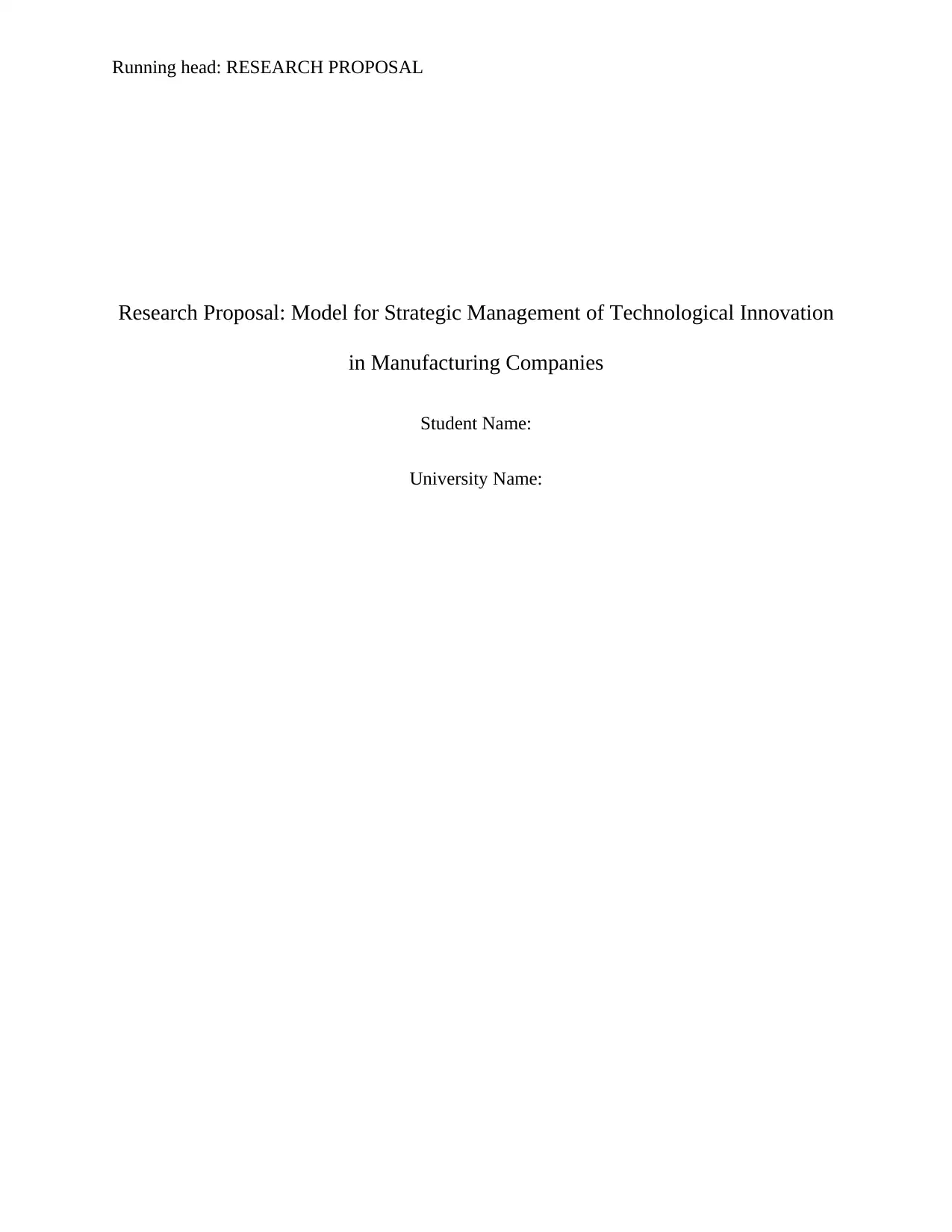
Running head: RESEARCH PROPOSAL
Research Proposal: Model for Strategic Management of Technological Innovation
in Manufacturing Companies
Student Name:
University Name:
Research Proposal: Model for Strategic Management of Technological Innovation
in Manufacturing Companies
Student Name:
University Name:
Paraphrase This Document
Need a fresh take? Get an instant paraphrase of this document with our AI Paraphraser
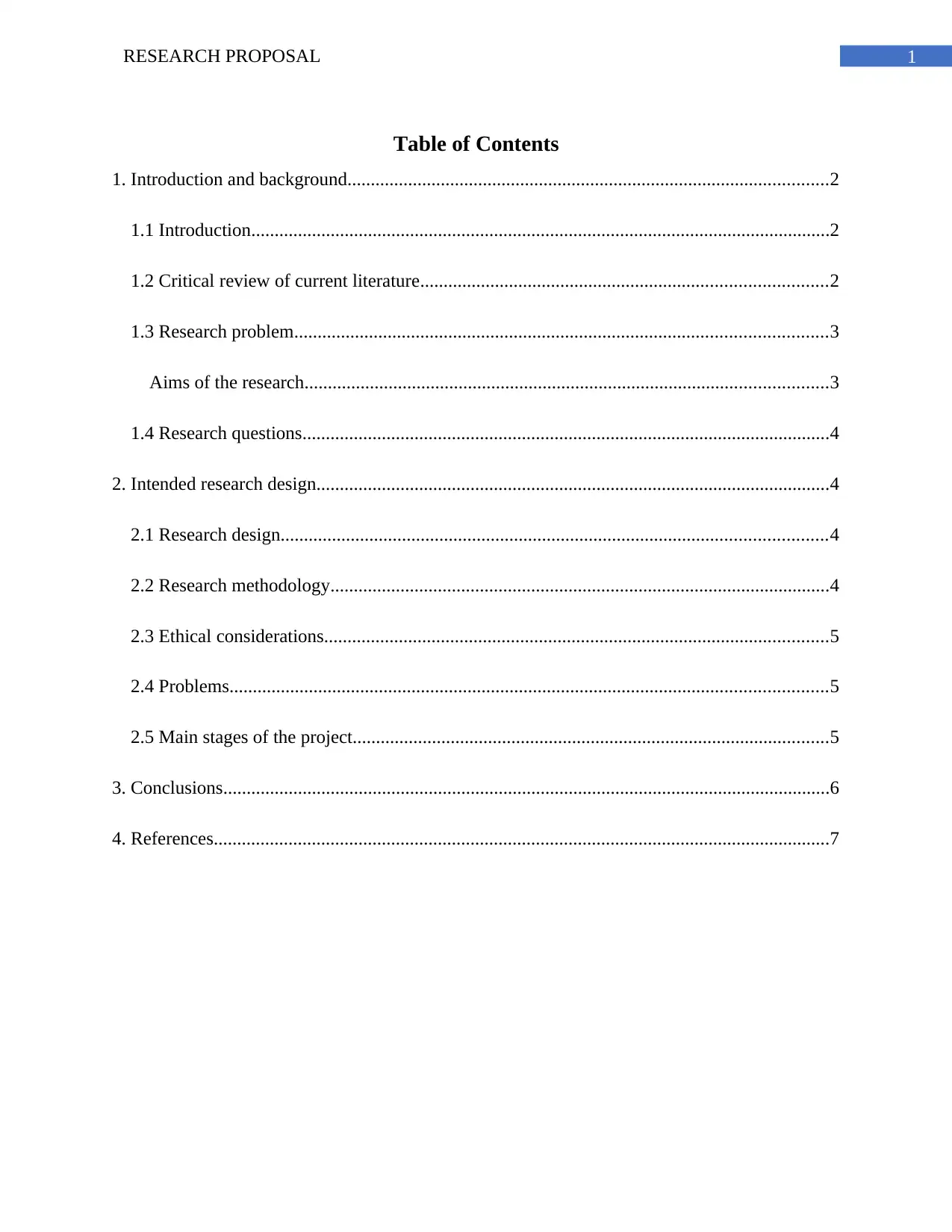
1RESEARCH PROPOSAL
Table of Contents
1. Introduction and background.......................................................................................................2
1.1 Introduction............................................................................................................................2
1.2 Critical review of current literature.......................................................................................2
1.3 Research problem..................................................................................................................3
Aims of the research................................................................................................................3
1.4 Research questions.................................................................................................................4
2. Intended research design..............................................................................................................4
2.1 Research design.....................................................................................................................4
2.2 Research methodology...........................................................................................................4
2.3 Ethical considerations............................................................................................................5
2.4 Problems................................................................................................................................5
2.5 Main stages of the project......................................................................................................5
3. Conclusions..................................................................................................................................6
4. References....................................................................................................................................7
Table of Contents
1. Introduction and background.......................................................................................................2
1.1 Introduction............................................................................................................................2
1.2 Critical review of current literature.......................................................................................2
1.3 Research problem..................................................................................................................3
Aims of the research................................................................................................................3
1.4 Research questions.................................................................................................................4
2. Intended research design..............................................................................................................4
2.1 Research design.....................................................................................................................4
2.2 Research methodology...........................................................................................................4
2.3 Ethical considerations............................................................................................................5
2.4 Problems................................................................................................................................5
2.5 Main stages of the project......................................................................................................5
3. Conclusions..................................................................................................................................6
4. References....................................................................................................................................7
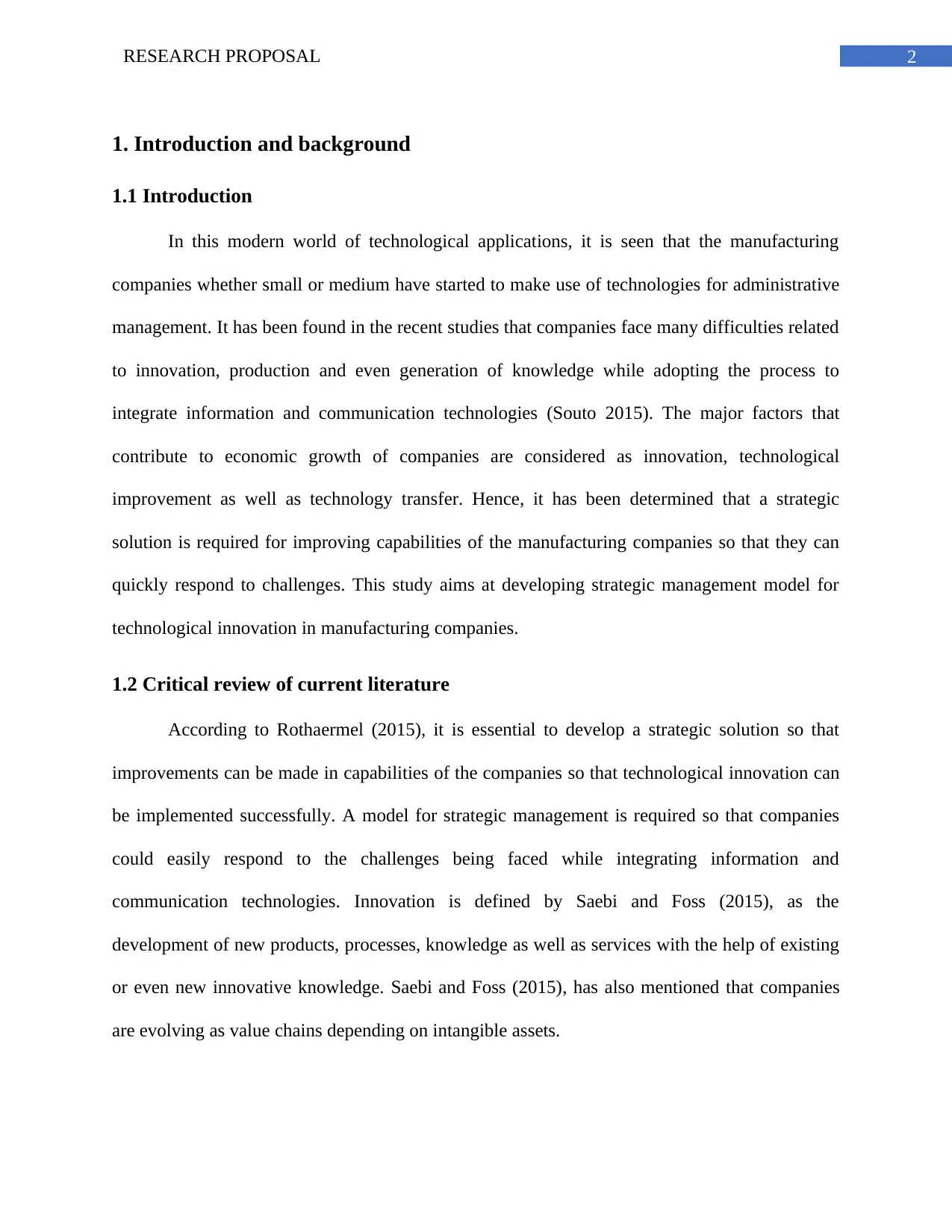
2RESEARCH PROPOSAL
1. Introduction and background
1.1 Introduction
In this modern world of technological applications, it is seen that the manufacturing
companies whether small or medium have started to make use of technologies for administrative
management. It has been found in the recent studies that companies face many difficulties related
to innovation, production and even generation of knowledge while adopting the process to
integrate information and communication technologies (Souto 2015). The major factors that
contribute to economic growth of companies are considered as innovation, technological
improvement as well as technology transfer. Hence, it has been determined that a strategic
solution is required for improving capabilities of the manufacturing companies so that they can
quickly respond to challenges. This study aims at developing strategic management model for
technological innovation in manufacturing companies.
1.2 Critical review of current literature
According to Rothaermel (2015), it is essential to develop a strategic solution so that
improvements can be made in capabilities of the companies so that technological innovation can
be implemented successfully. A model for strategic management is required so that companies
could easily respond to the challenges being faced while integrating information and
communication technologies. Innovation is defined by Saebi and Foss (2015), as the
development of new products, processes, knowledge as well as services with the help of existing
or even new innovative knowledge. Saebi and Foss (2015), has also mentioned that companies
are evolving as value chains depending on intangible assets.
1. Introduction and background
1.1 Introduction
In this modern world of technological applications, it is seen that the manufacturing
companies whether small or medium have started to make use of technologies for administrative
management. It has been found in the recent studies that companies face many difficulties related
to innovation, production and even generation of knowledge while adopting the process to
integrate information and communication technologies (Souto 2015). The major factors that
contribute to economic growth of companies are considered as innovation, technological
improvement as well as technology transfer. Hence, it has been determined that a strategic
solution is required for improving capabilities of the manufacturing companies so that they can
quickly respond to challenges. This study aims at developing strategic management model for
technological innovation in manufacturing companies.
1.2 Critical review of current literature
According to Rothaermel (2015), it is essential to develop a strategic solution so that
improvements can be made in capabilities of the companies so that technological innovation can
be implemented successfully. A model for strategic management is required so that companies
could easily respond to the challenges being faced while integrating information and
communication technologies. Innovation is defined by Saebi and Foss (2015), as the
development of new products, processes, knowledge as well as services with the help of existing
or even new innovative knowledge. Saebi and Foss (2015), has also mentioned that companies
are evolving as value chains depending on intangible assets.
⊘ This is a preview!⊘
Do you want full access?
Subscribe today to unlock all pages.

Trusted by 1+ million students worldwide
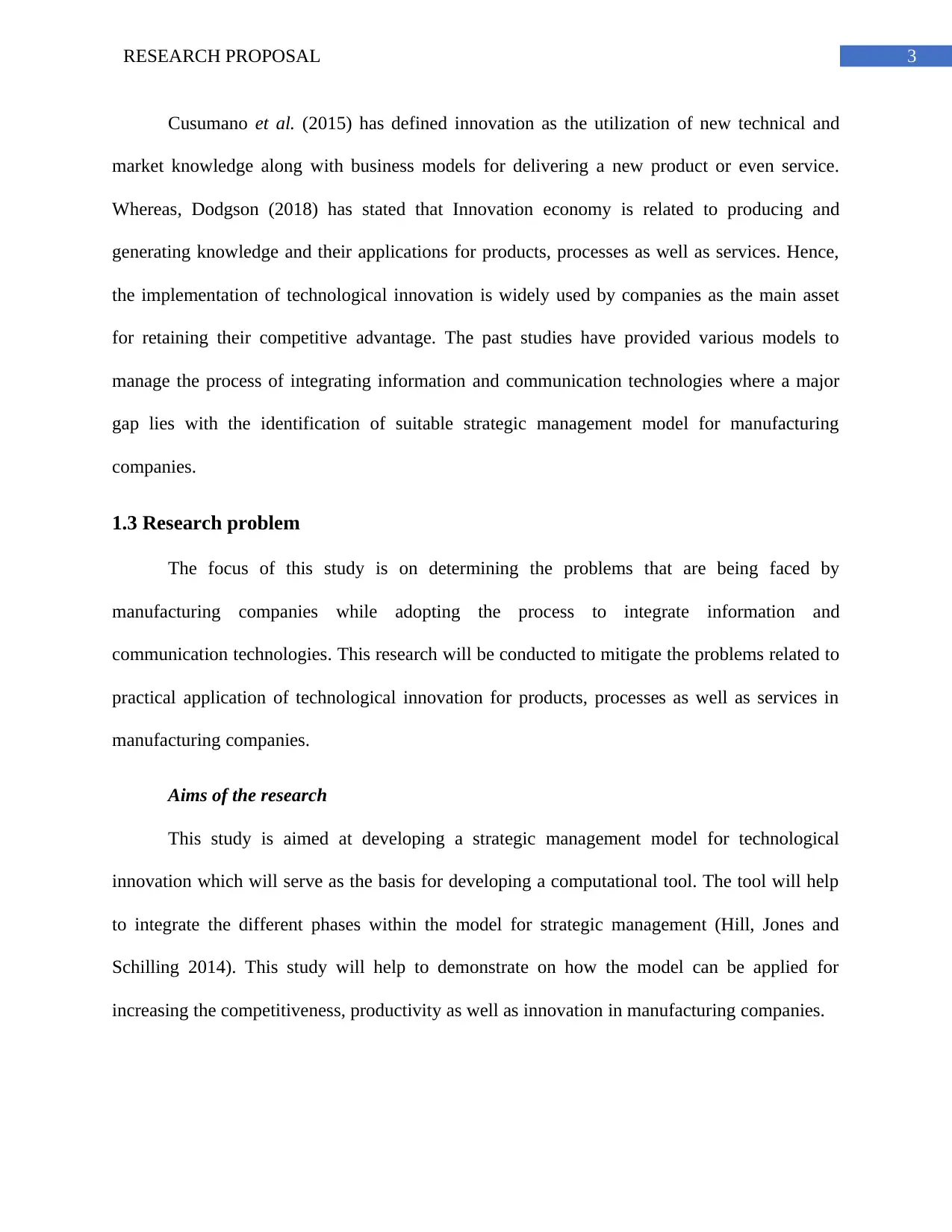
3RESEARCH PROPOSAL
Cusumano et al. (2015) has defined innovation as the utilization of new technical and
market knowledge along with business models for delivering a new product or even service.
Whereas, Dodgson (2018) has stated that Innovation economy is related to producing and
generating knowledge and their applications for products, processes as well as services. Hence,
the implementation of technological innovation is widely used by companies as the main asset
for retaining their competitive advantage. The past studies have provided various models to
manage the process of integrating information and communication technologies where a major
gap lies with the identification of suitable strategic management model for manufacturing
companies.
1.3 Research problem
The focus of this study is on determining the problems that are being faced by
manufacturing companies while adopting the process to integrate information and
communication technologies. This research will be conducted to mitigate the problems related to
practical application of technological innovation for products, processes as well as services in
manufacturing companies.
Aims of the research
This study is aimed at developing a strategic management model for technological
innovation which will serve as the basis for developing a computational tool. The tool will help
to integrate the different phases within the model for strategic management (Hill, Jones and
Schilling 2014). This study will help to demonstrate on how the model can be applied for
increasing the competitiveness, productivity as well as innovation in manufacturing companies.
Cusumano et al. (2015) has defined innovation as the utilization of new technical and
market knowledge along with business models for delivering a new product or even service.
Whereas, Dodgson (2018) has stated that Innovation economy is related to producing and
generating knowledge and their applications for products, processes as well as services. Hence,
the implementation of technological innovation is widely used by companies as the main asset
for retaining their competitive advantage. The past studies have provided various models to
manage the process of integrating information and communication technologies where a major
gap lies with the identification of suitable strategic management model for manufacturing
companies.
1.3 Research problem
The focus of this study is on determining the problems that are being faced by
manufacturing companies while adopting the process to integrate information and
communication technologies. This research will be conducted to mitigate the problems related to
practical application of technological innovation for products, processes as well as services in
manufacturing companies.
Aims of the research
This study is aimed at developing a strategic management model for technological
innovation which will serve as the basis for developing a computational tool. The tool will help
to integrate the different phases within the model for strategic management (Hill, Jones and
Schilling 2014). This study will help to demonstrate on how the model can be applied for
increasing the competitiveness, productivity as well as innovation in manufacturing companies.
Paraphrase This Document
Need a fresh take? Get an instant paraphrase of this document with our AI Paraphraser
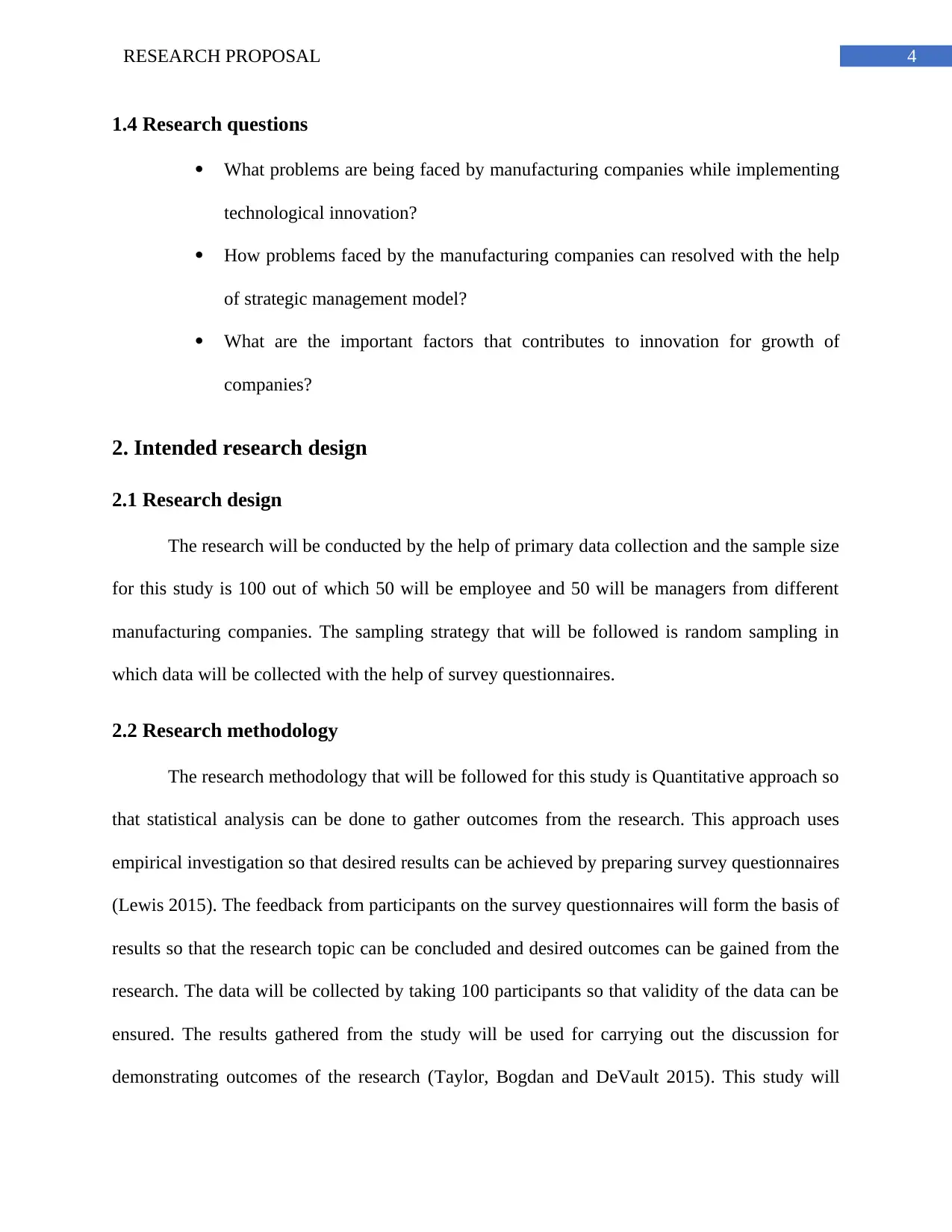
4RESEARCH PROPOSAL
1.4 Research questions
What problems are being faced by manufacturing companies while implementing
technological innovation?
How problems faced by the manufacturing companies can resolved with the help
of strategic management model?
What are the important factors that contributes to innovation for growth of
companies?
2. Intended research design
2.1 Research design
The research will be conducted by the help of primary data collection and the sample size
for this study is 100 out of which 50 will be employee and 50 will be managers from different
manufacturing companies. The sampling strategy that will be followed is random sampling in
which data will be collected with the help of survey questionnaires.
2.2 Research methodology
The research methodology that will be followed for this study is Quantitative approach so
that statistical analysis can be done to gather outcomes from the research. This approach uses
empirical investigation so that desired results can be achieved by preparing survey questionnaires
(Lewis 2015). The feedback from participants on the survey questionnaires will form the basis of
results so that the research topic can be concluded and desired outcomes can be gained from the
research. The data will be collected by taking 100 participants so that validity of the data can be
ensured. The results gathered from the study will be used for carrying out the discussion for
demonstrating outcomes of the research (Taylor, Bogdan and DeVault 2015). This study will
1.4 Research questions
What problems are being faced by manufacturing companies while implementing
technological innovation?
How problems faced by the manufacturing companies can resolved with the help
of strategic management model?
What are the important factors that contributes to innovation for growth of
companies?
2. Intended research design
2.1 Research design
The research will be conducted by the help of primary data collection and the sample size
for this study is 100 out of which 50 will be employee and 50 will be managers from different
manufacturing companies. The sampling strategy that will be followed is random sampling in
which data will be collected with the help of survey questionnaires.
2.2 Research methodology
The research methodology that will be followed for this study is Quantitative approach so
that statistical analysis can be done to gather outcomes from the research. This approach uses
empirical investigation so that desired results can be achieved by preparing survey questionnaires
(Lewis 2015). The feedback from participants on the survey questionnaires will form the basis of
results so that the research topic can be concluded and desired outcomes can be gained from the
research. The data will be collected by taking 100 participants so that validity of the data can be
ensured. The results gathered from the study will be used for carrying out the discussion for
demonstrating outcomes of the research (Taylor, Bogdan and DeVault 2015). This study will
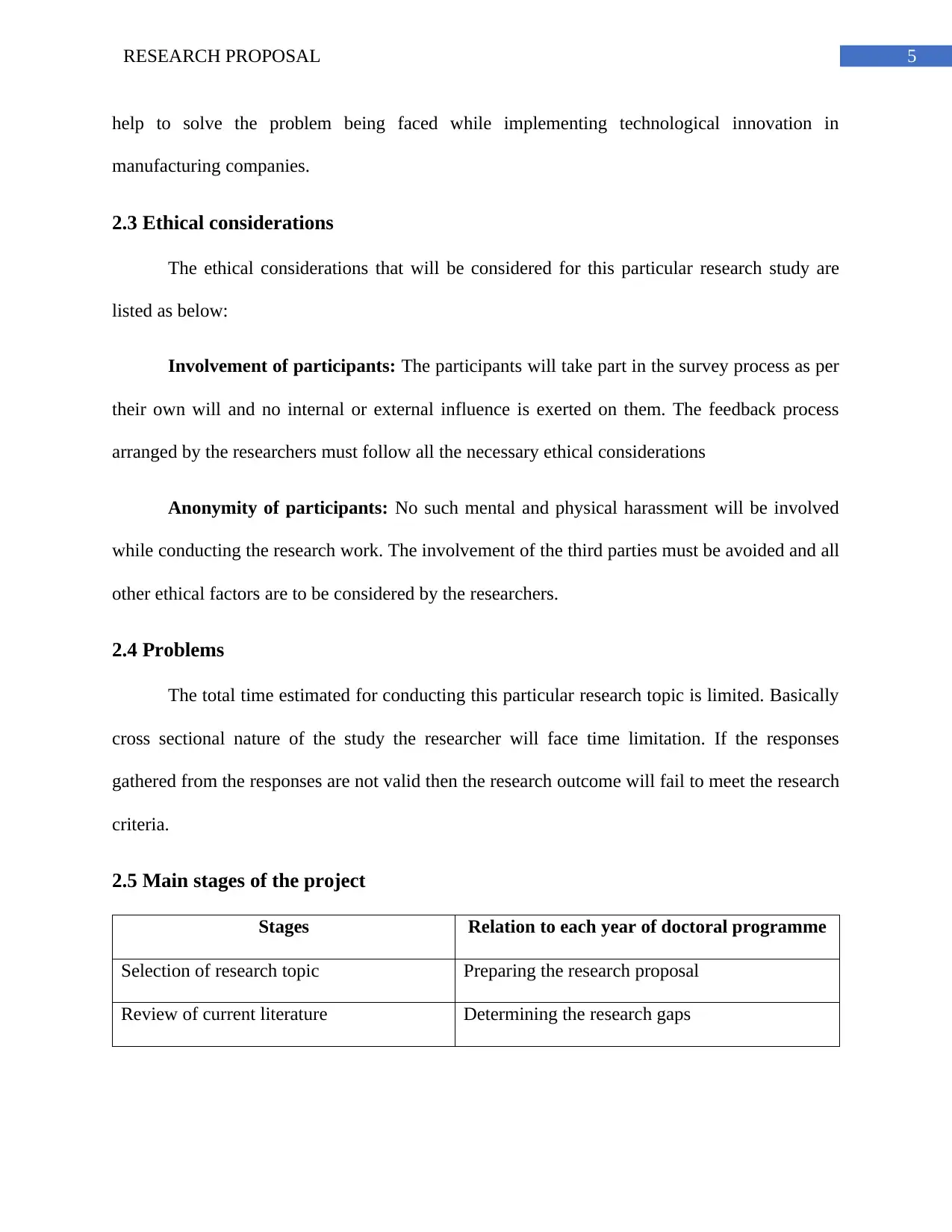
5RESEARCH PROPOSAL
help to solve the problem being faced while implementing technological innovation in
manufacturing companies.
2.3 Ethical considerations
The ethical considerations that will be considered for this particular research study are
listed as below:
Involvement of participants: The participants will take part in the survey process as per
their own will and no internal or external influence is exerted on them. The feedback process
arranged by the researchers must follow all the necessary ethical considerations
Anonymity of participants: No such mental and physical harassment will be involved
while conducting the research work. The involvement of the third parties must be avoided and all
other ethical factors are to be considered by the researchers.
2.4 Problems
The total time estimated for conducting this particular research topic is limited. Basically
cross sectional nature of the study the researcher will face time limitation. If the responses
gathered from the responses are not valid then the research outcome will fail to meet the research
criteria.
2.5 Main stages of the project
Stages Relation to each year of doctoral programme
Selection of research topic Preparing the research proposal
Review of current literature Determining the research gaps
help to solve the problem being faced while implementing technological innovation in
manufacturing companies.
2.3 Ethical considerations
The ethical considerations that will be considered for this particular research study are
listed as below:
Involvement of participants: The participants will take part in the survey process as per
their own will and no internal or external influence is exerted on them. The feedback process
arranged by the researchers must follow all the necessary ethical considerations
Anonymity of participants: No such mental and physical harassment will be involved
while conducting the research work. The involvement of the third parties must be avoided and all
other ethical factors are to be considered by the researchers.
2.4 Problems
The total time estimated for conducting this particular research topic is limited. Basically
cross sectional nature of the study the researcher will face time limitation. If the responses
gathered from the responses are not valid then the research outcome will fail to meet the research
criteria.
2.5 Main stages of the project
Stages Relation to each year of doctoral programme
Selection of research topic Preparing the research proposal
Review of current literature Determining the research gaps
⊘ This is a preview!⊘
Do you want full access?
Subscribe today to unlock all pages.

Trusted by 1+ million students worldwide
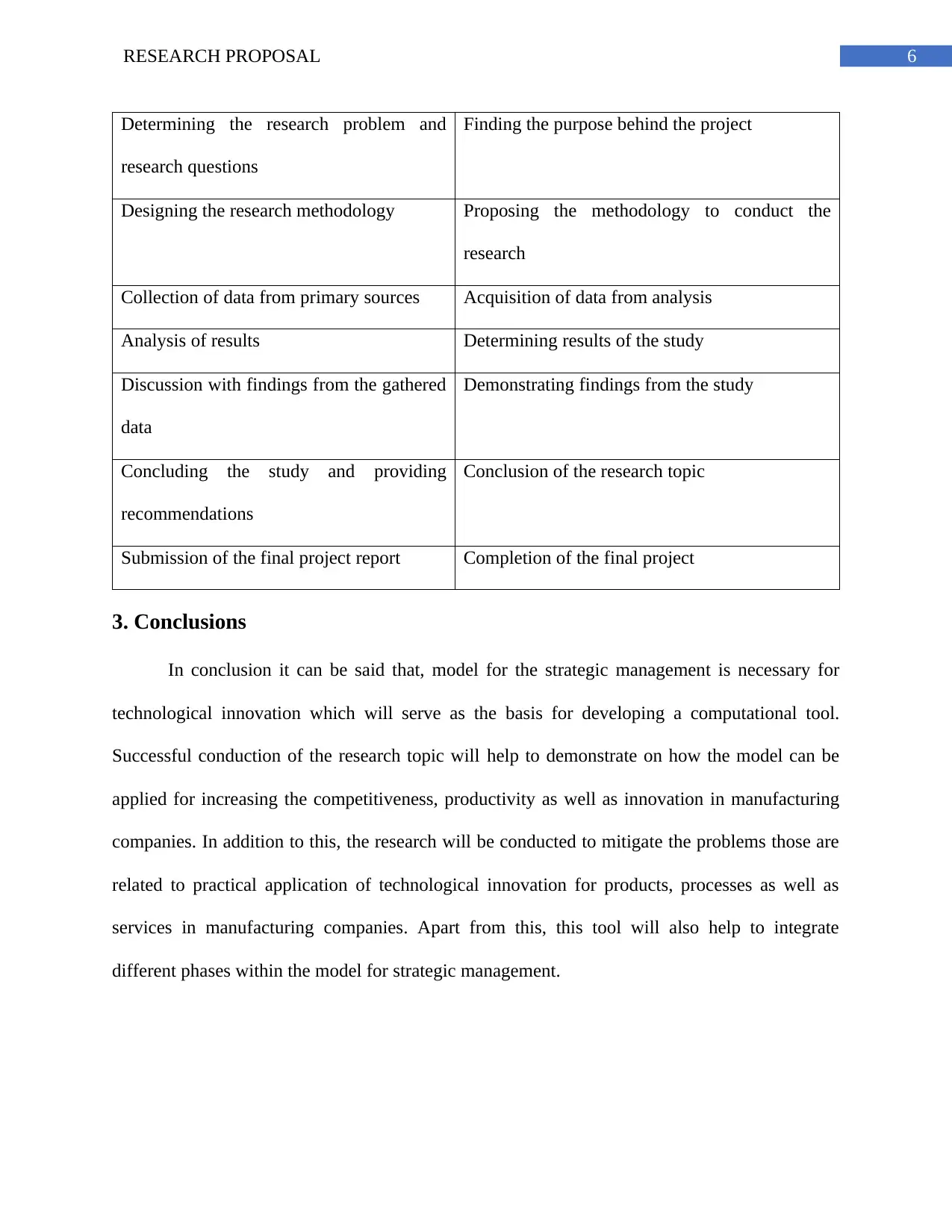
6RESEARCH PROPOSAL
Determining the research problem and
research questions
Finding the purpose behind the project
Designing the research methodology Proposing the methodology to conduct the
research
Collection of data from primary sources Acquisition of data from analysis
Analysis of results Determining results of the study
Discussion with findings from the gathered
data
Demonstrating findings from the study
Concluding the study and providing
recommendations
Conclusion of the research topic
Submission of the final project report Completion of the final project
3. Conclusions
In conclusion it can be said that, model for the strategic management is necessary for
technological innovation which will serve as the basis for developing a computational tool.
Successful conduction of the research topic will help to demonstrate on how the model can be
applied for increasing the competitiveness, productivity as well as innovation in manufacturing
companies. In addition to this, the research will be conducted to mitigate the problems those are
related to practical application of technological innovation for products, processes as well as
services in manufacturing companies. Apart from this, this tool will also help to integrate
different phases within the model for strategic management.
Determining the research problem and
research questions
Finding the purpose behind the project
Designing the research methodology Proposing the methodology to conduct the
research
Collection of data from primary sources Acquisition of data from analysis
Analysis of results Determining results of the study
Discussion with findings from the gathered
data
Demonstrating findings from the study
Concluding the study and providing
recommendations
Conclusion of the research topic
Submission of the final project report Completion of the final project
3. Conclusions
In conclusion it can be said that, model for the strategic management is necessary for
technological innovation which will serve as the basis for developing a computational tool.
Successful conduction of the research topic will help to demonstrate on how the model can be
applied for increasing the competitiveness, productivity as well as innovation in manufacturing
companies. In addition to this, the research will be conducted to mitigate the problems those are
related to practical application of technological innovation for products, processes as well as
services in manufacturing companies. Apart from this, this tool will also help to integrate
different phases within the model for strategic management.
Paraphrase This Document
Need a fresh take? Get an instant paraphrase of this document with our AI Paraphraser
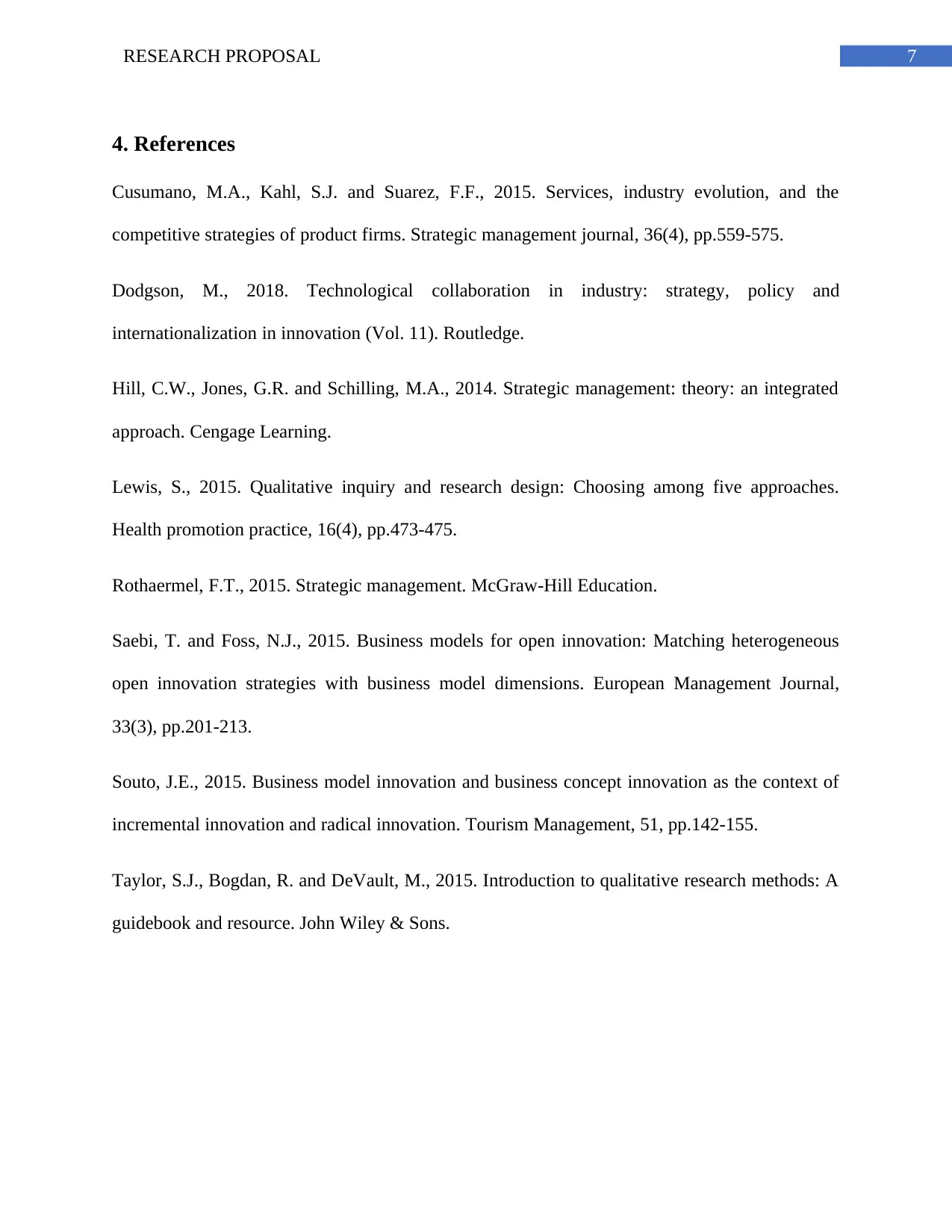
7RESEARCH PROPOSAL
4. References
Cusumano, M.A., Kahl, S.J. and Suarez, F.F., 2015. Services, industry evolution, and the
competitive strategies of product firms. Strategic management journal, 36(4), pp.559-575.
Dodgson, M., 2018. Technological collaboration in industry: strategy, policy and
internationalization in innovation (Vol. 11). Routledge.
Hill, C.W., Jones, G.R. and Schilling, M.A., 2014. Strategic management: theory: an integrated
approach. Cengage Learning.
Lewis, S., 2015. Qualitative inquiry and research design: Choosing among five approaches.
Health promotion practice, 16(4), pp.473-475.
Rothaermel, F.T., 2015. Strategic management. McGraw-Hill Education.
Saebi, T. and Foss, N.J., 2015. Business models for open innovation: Matching heterogeneous
open innovation strategies with business model dimensions. European Management Journal,
33(3), pp.201-213.
Souto, J.E., 2015. Business model innovation and business concept innovation as the context of
incremental innovation and radical innovation. Tourism Management, 51, pp.142-155.
Taylor, S.J., Bogdan, R. and DeVault, M., 2015. Introduction to qualitative research methods: A
guidebook and resource. John Wiley & Sons.
4. References
Cusumano, M.A., Kahl, S.J. and Suarez, F.F., 2015. Services, industry evolution, and the
competitive strategies of product firms. Strategic management journal, 36(4), pp.559-575.
Dodgson, M., 2018. Technological collaboration in industry: strategy, policy and
internationalization in innovation (Vol. 11). Routledge.
Hill, C.W., Jones, G.R. and Schilling, M.A., 2014. Strategic management: theory: an integrated
approach. Cengage Learning.
Lewis, S., 2015. Qualitative inquiry and research design: Choosing among five approaches.
Health promotion practice, 16(4), pp.473-475.
Rothaermel, F.T., 2015. Strategic management. McGraw-Hill Education.
Saebi, T. and Foss, N.J., 2015. Business models for open innovation: Matching heterogeneous
open innovation strategies with business model dimensions. European Management Journal,
33(3), pp.201-213.
Souto, J.E., 2015. Business model innovation and business concept innovation as the context of
incremental innovation and radical innovation. Tourism Management, 51, pp.142-155.
Taylor, S.J., Bogdan, R. and DeVault, M., 2015. Introduction to qualitative research methods: A
guidebook and resource. John Wiley & Sons.
1 out of 8
Related Documents
Your All-in-One AI-Powered Toolkit for Academic Success.
+13062052269
info@desklib.com
Available 24*7 on WhatsApp / Email
![[object Object]](/_next/static/media/star-bottom.7253800d.svg)
Unlock your academic potential
Copyright © 2020–2025 A2Z Services. All Rights Reserved. Developed and managed by ZUCOL.





